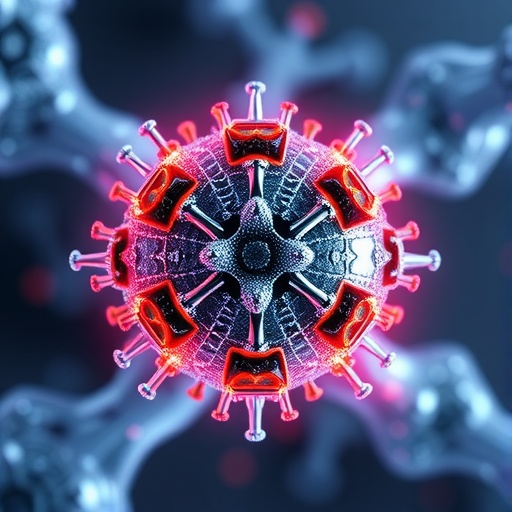In the rapidly evolving field of sustainable energy, the hydrogen evolution reaction (HER) remains a cornerstone for efficient hydrogen production through water electrolysis. This reaction, especially under alkaline conditions, requires catalysts that not only exhibit high activity but also withstand the rigorous operational environment of electrolyzers. Platinum (Pt) continues to be the benchmark catalyst for HER due to its exceptional inherent catalytic properties. However, a critical challenge lies in refining the surface interactions on Pt electrodes to surpass its activity limits and realize practical, large-scale hydrogen generation. Recent groundbreaking research introduces a molecular design strategy that pioneers the use of tailored organic overlayers on Pt electrodes, unlocking unprecedented enhancements in HER activity.
The conventional approach to improving platinum catalysts has heavily focused on alloying, morphology tuning, and compositional variations. While these techniques have yielded incremental gains, the scientific community has grappled with establishing a unifying theoretical framework to guide the rational design of electrode surfaces specifically for HER. The study in question addresses this gap by revealing how molecular engineering of organic adsorbates on platinum surfaces offers a strategic pathway to modulate crucial electronic characteristics, thereby drastically amplifying catalytic performance in alkaline media.
Delving deeper into the molecular parameters, the study indicates that the binding energies of organic adsorbates to Pt surfaces are directly linked to their structural features—namely, the number of aromatic rings present and the hydrophilicity of the molecules. These attributes govern the adsorbate’s adherence to the platinum substrate and, consequently, its ability to modulate surface properties. Molecules with optimized aromaticity and balanced hydrophilic character promote an ideal interplay between surface coverage and electronic influence, steering hydrogen adsorption towards an optimal binding strength.
Expanding beyond theoretical and fundamental analysis, the research team validated their findings in practical device configurations. They demonstrated the enhancing effect of a 2,2′-bipyrimidine organic overlayer on commercial Pt/C catalysts integrated into a membrane electrode assembly (MEA) within a water electrolyzer setup. The device-level tests confirmed the significance of molecularly engineered electrodes, with substantial activity improvements translating into lower overpotentials and increased current densities under operational conditions.
The successful deployment in MEA-configured electrolyzers is particularly noteworthy given the complexities of scaling molecular modifications from controlled laboratory conditions to mass-produced devices. This achievement suggests promising implications for the industrial adoption of molecularly tailored catalyst surfaces, potentially reducing the platinum load, cutting costs, and improving overall electrolyzer efficiency.
One of the profound implications of this study lies in its capacity to inspire a paradigm shift in catalyst design. Traditionally, catalyst improvement efforts have been resource-intensive and empirical. The demonstrated correlation between molecular structure, binding energies, electronic modulation, and catalytic activity introduces a predictive framework whereby chemists and materials scientists can design new organic modifiers with targeted functionalities.
The versatility of this molecular design strategy could extend beyond Pt and HER, potentially influencing a broad spectrum of electrochemical reactions where surface binding energies dictate performance, such as oxygen reduction, CO2 reduction, and nitrogen fixation. By exploiting organic-inorganic hybrid interfaces, researchers can access a rich chemical space that harmonizes molecular recognition with catalytic functionality.
Additionally, the study’s integrated methodology, combining experimental electrochemistry, surface characterization, and computational modeling, exemplifies the power of multidisciplinary approaches in addressing complex catalytic challenges. The synergy between theory and practice accelerates the understanding of fundamental processes while guiding the design of next-generation catalysts.
In terms of fundamental electrochemical kinetics, this approach enriches understanding of the Volmer step—hydrogen adsorption and discharge—and the Tafel step—molecular hydrogen formation and desorption—by reshaping the catalyst’s adsorption landscape. The fine-tuned weakening of hydrogen binding facilitates faster desorption without compromising adsorption, effectively balancing the Sabatier principle for optimal HER catalysis.
Moreover, the specific choice of 2,2′-bipyrimidine as a molecular overlayer is intriguing given its heteroaromatic nitrogen sites, which may contribute to localized electron donation or withdrawal effects, influencing the electronic structure of adjacent Pt atoms. Such functional groups could serve dual roles, modifying both surface electronic properties and interfacial water orientation, further enhancing catalytic activity.
The implications of these findings resonate strongly in the quest for clean hydrogen fuels. By substantially improving catalyst efficiency and potentially lowering precious metal content, this molecular design approach could accelerate the global transition to hydrogen-based energy systems, contributing to decarbonization goals and energy sustainability.
In conclusion, the work by Zhao, Xiang, Wang, and colleagues epitomizes a new frontier in electrocatalysis, wherein molecular design principles are harnessed to redefine surface chemistry of platinum electrodes for hydrogen evolution. Their discovery of organic overlayers capable of modulating Pt’s d-band center and hydrogen adsorption energetics offers an elegant, scalable, and effective strategy to elevate HER performance. As electrochemical technologies advance, such innovations promise to shape the landscape of renewable energy conversion and storage.
—
Subject of Research: Electrode surface molecular design for enhanced hydrogen evolution reaction (HER) catalysis on platinum electrodes.
Article Title: A molecular design strategy to enhance hydrogen evolution on platinum electrocatalysts.
Article References:
Zhao, K., Xiang, N., Wang, YQ. et al. A molecular design strategy to enhance hydrogen evolution on platinum electrocatalysts.
Nat Energy (2025). https://doi.org/10.1038/s41560-025-01754-4
Image Credits: AI Generated
Tags: alkaline water electrolysis advancementschallenges in platinum catalyst developmentelectrochemical reaction engineeringhydrogen evolution reaction catalystsimproving catalytic performanceinnovative approaches to hydrogen generationmolecular design in catalysisoptimizing platinum for HERorganic overlayers on platinumplatinum electrode enhancementssurface interactions in catalysissustainable hydrogen production strategies





